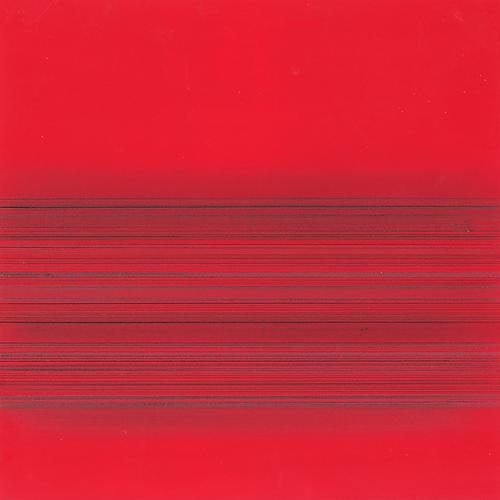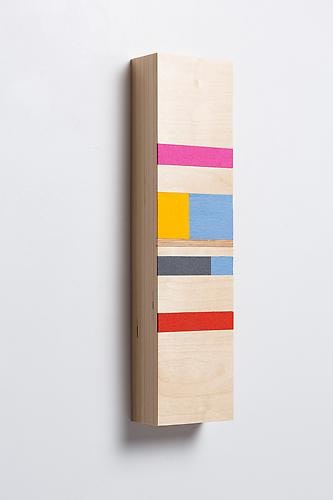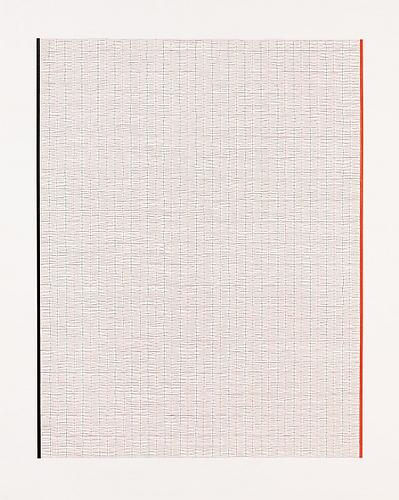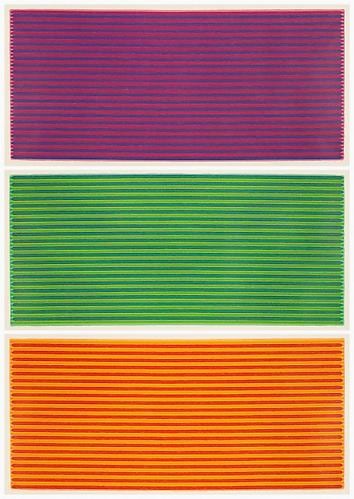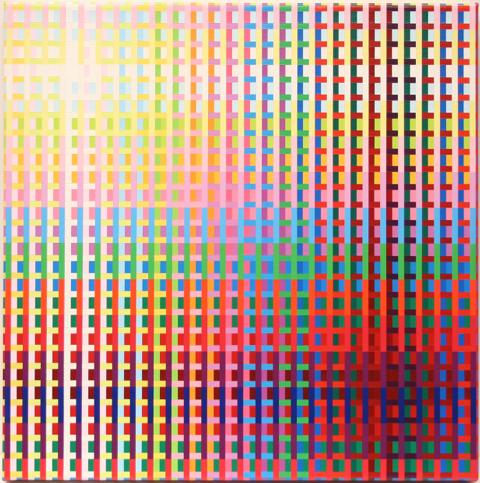17 Sep. 2015
Garvey|Simon Art Access is pleased to announce STRAIGHT LINES IN FIVE DIRECTIONS, a group exhibition featuring works by Kate Carr, Susie Rosmarin, Susan Schwalb, James Siena and Dan Walsh. The exhibition will run from July 23 – August 23, 2013. The Opening Reception will take place on Thursday, July 25, from 5–8 pm, in conjunction with Chelsea Art Walk 2013.
The line is perhaps the most basic element in art, and yet these five artists very individually and complexly use straight lines as dominant formal devices to express their artistic objectives. The title of the show is a riff on a typical Sol LeWitt title – he being an art historical master of line. It is also a metaphor since each of these five artists use line in distinctly different ways.
Kate Carr uses simple, geometric forms and materials with linear edges to build an abstract visual vocabulary of lines and planes. At its inception, her materials dictate the work: colored felt and plywood. By stacking pieces of these utilitarian materials, Carr creates line three-dimensionally on her small, totemic sculptures. This creates a context for juxtapositions of materials to occur: hard and soft, smooth and textured, loose and dense, heavy and light, brightly hued and neutral. The familiar and tactile quality of her humble ingredients creates immediate and intimate connectivity to the work. As she states: I see line in my materials. I look for line in the world. It has a rhythm, a hum. It both differentiates space and connects it. A line is the simplest mark. It is a part of a whole. In my work I use simple geometric forms because they allow my materials to be seen and encountered clearly, unencumbered by their shape.
Susan Schwalb is a contemporary master of silverpoint drawing, a Renaissance technique used by Leonardo and Dürer, and a medium that naturally gives itself to linearity. A lost art to many, it has been Schwalb’s medium of choice for the last 30+ years of her career. Schwalb has reinvented the technique and actually uses a variety of metals (silver, gold, brass, aluminum, bronze, copper etc.) laid down in delicate horizontal lines to create abstract bands of thinly rendered metal across the surface of both paper and panel. She uses a variety of metal tools to create her tonal surfaces – a stylus for line, flat pieces of metal to achieve a shimmering atmosphere, and even metal pads to create unusual textures. Layering, line and light are the most important components of her meditative compositions.
Geometric grids filled with intense color are the means by which Susie Rosmarin navigates her use of line. She creates a vast network of lines in each work, saturated with potent colors, which when put together generate undulating hues and vibrating surfaces. Her main objective is to reveal the incredible amount of expression that can be wrought just from lines. Her use of a strict grid emphasizes her desire for technical perfection. She says: I don’t use the computer. I make preparatory sketches because I have to be very careful in my layout. I lay paint and put tape down where I want bands of color, then paint and more tape. I work from light to dark. Lines are a very important part of abstract painting. You’re always working off the past, but trying to do something new. Rosmarin’s abstractions actively animate themselves in their otherwise two-dimensional plane. They represent the constant battle between reality and illusion.
Perceptual tension created by the interplay of colors and geometries has been an integral part of Dan Walsh’s work since the 1990s. His quirky, linear geometry is often strikingly minimalistic. In his OGV woodcuts (which stands for the three secondary colors: orange, green and violet) he uses the repetition of horizontal lines to create a juxtaposition of colors through layering. The alternating of light and dark correlate to the density of the lines; there is a perspectival deception as their flat surfaces appear to advance and recede simultaneously. The wood grain patterns of the panels emerge, giving an organic facet to the works. Another edition of the OGV triptych in this show, as well as the entire suite, Portfolio B, are found in the permanent collection of MoMA.
James Siena creates his images with the organic configuration of line. Each of his compositions is created from a set of self-imposed rules, which he implements as a challenge to himself. The resulting individual marks combine to create complex abstract designs based on these algorithms and patterns. Siena is a master of simplicity yet his depictions manage to capture the macroscopic as well as the microscopic. His work stimulates both the eye and the brain. As Roberta Smith wrote in an early review of his paintings: Mr. Siena is unusually adept at translating the mental into the visual. His paintings think as good as they look. His works are meant to subtly empower us to “think about how we think.”
For more information or high-resolution images, please contact Elizabeth Garvey, 917-796-2146 or liz@gsartaccess.com.
gallery hours: Tuesday-Saturday, 10-6

